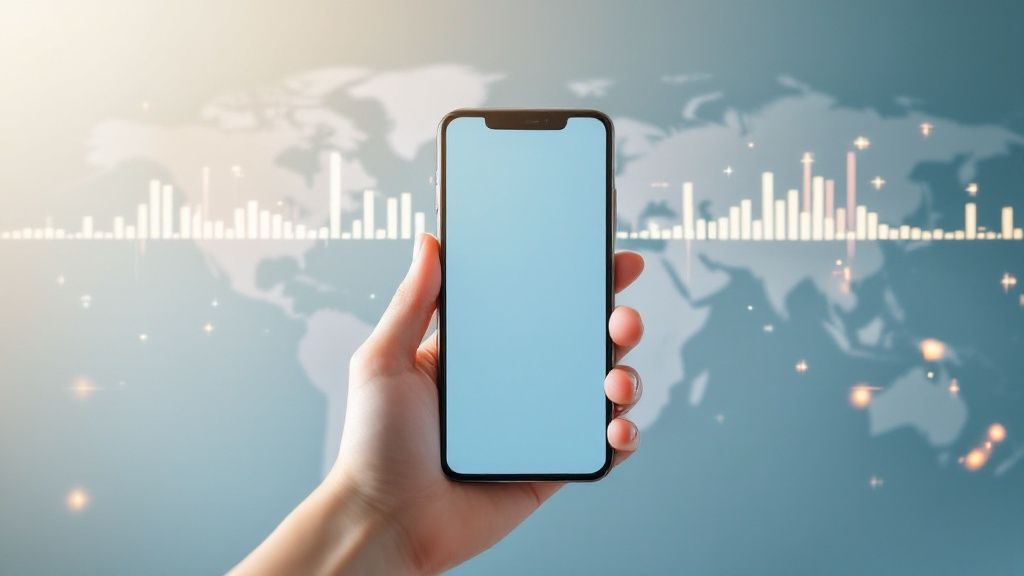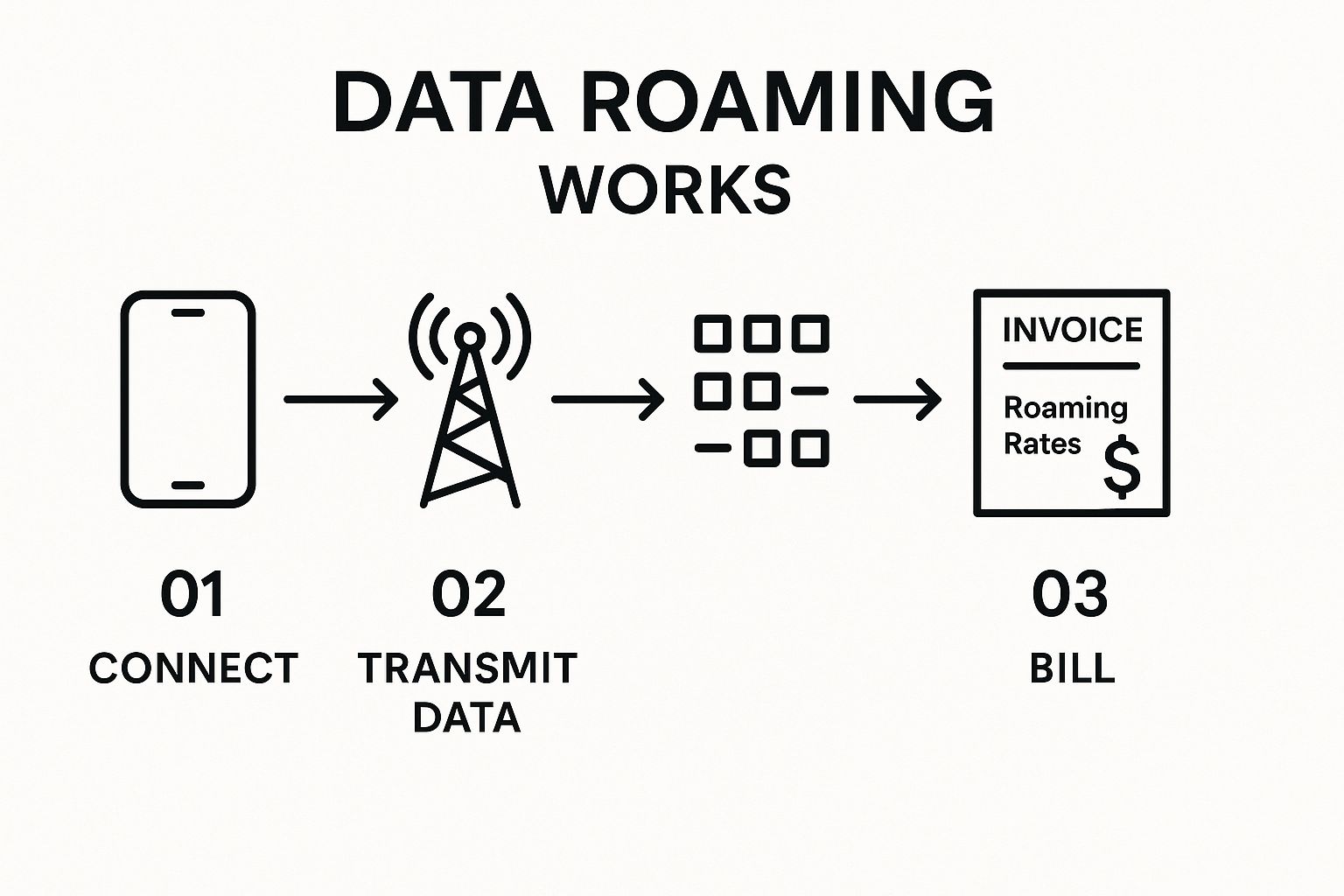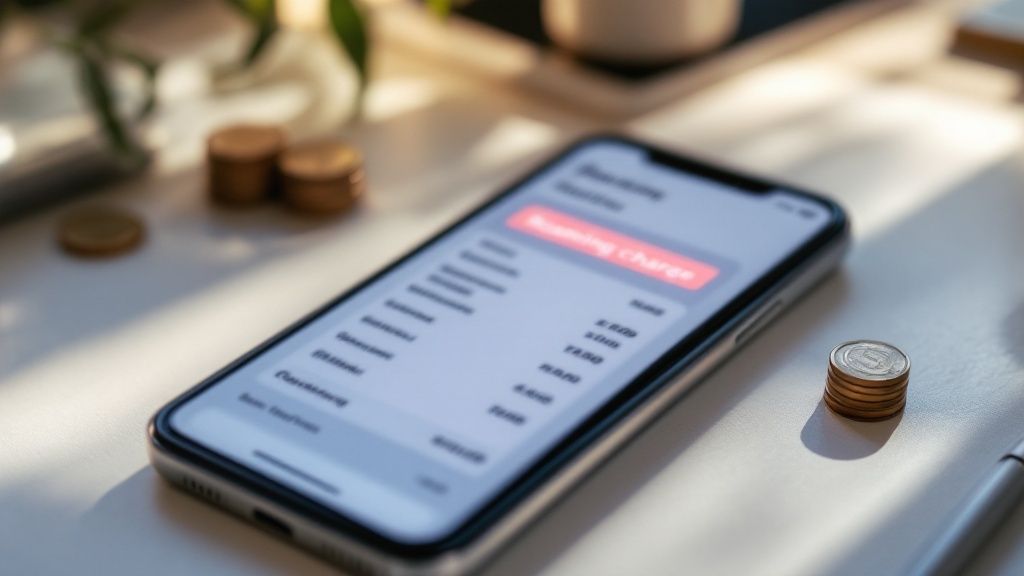Ever wondered what data roaming actually is? Put simply, it’s what allows your phone to connect to the internet using a foreign mobile network when you’re travelling outside your usual Australian coverage area.
Think of it as your phone temporarily borrowing another company's mobile towers to keep you online. It’s incredibly convenient, but that convenience almost always comes with a price tag.
What Does Data Roaming Really Mean?

Imagine your mobile provider, like Telstra or Optus, operates within a set territory. The moment you step outside this "home" zone—whether you're crossing an international border or just hitting a remote spot in the Aussie outback—your phone loses its direct signal. Data roaming is the tech that swoops in to save the day.
Your home provider has agreements with other mobile networks all over the world. These partnerships allow your device to do a sort of digital 'handshake' with a local "guest network," giving you access to its internet services.
This is what lets you:
- Fire up Google Maps to find that hidden cafe.
- Send holiday snaps on WhatsApp or iMessage.
- Scroll through Instagram and check your emails.
Basically, you become a guest on another network. That guest network then bills your home provider for the data you use, and your provider passes those costs—often with a hefty markup—straight on to you.
Before we get into the nitty-gritty, let's break down some of the key terms you'll come across. For a bit more background, you might find our guide on what automatic roaming is helpful.
Key Data Roaming Terms at a Glance
Here's a quick rundown of the essential terms you'll see when dealing with data roaming.
| Term | Simple Meaning |
|---|---|
| Home Network | Your primary Australian mobile provider (e.g., Telstra, Optus, Vodafone). |
| Guest Network | A foreign mobile provider your phone connects to when you are abroad. |
| Roaming Charges | The extra fees you pay for using a guest network's services. |
Understanding these basics is the first step to avoiding that dreaded post-holiday phone bill.
How Data Roaming Actually Works When You Travel
The moment you switch your phone off airplane mode in a new country, a surprisingly fast and complex process kicks off. Your phone starts looking for its home network signal, but when it can't find it, it immediately begins searching for a friendly "guest" network it can connect to instead.
Think of it as a digital handshake. Your Aussie provider, whether it's Telstra or Optus, has already set up agreements with mobile carriers all over the world. These partnerships act as a trusted introduction, letting the foreign network know your SIM card is legitimate and giving your phone access to its towers for calls, texts, and that all-important data.
The Journey of Your Data
Once your phone is connected, it can send and receive data just like at home. The foreign network takes care of the local connection, but it sends all the usage and billing information straight back to your provider in Australia. This is why you get one simple bill from your Aussie telco, even if you’ve been using a network on the other side of the planet.
At its heart, data roaming is all about this partnership: a foreign network provides the service on the ground, while your home network handles the authorisation and billing. This seamless teamwork is what makes global connectivity possible for millions of travellers.
This infographic breaks down the simple three-step process your phone goes through to connect overseas.

As the graphic shows, the cycle of connecting, using data, and then billing is what leads to those extra roaming costs we all want to avoid.
The demand for this technology is huge, especially considering how connected we are in Australia. As of January 2025, there were 34.4 million mobile connections in the country—that's 128% of our total population! This shows just how much we rely on our phones, making roaming services pretty much essential for anyone travelling abroad. You can learn more about Australia's digital landscape on datareportal.com.
The True Cost of Roaming and How Charges Add Up

We’ve all heard the horror stories. That sinking feeling when you open your phone bill after a dream holiday, only to be slapped with hundreds—or even thousands—of dollars in roaming charges. It’s the quickest way to ruin your post-travel glow.
Understanding what data roaming is helps, but the real trick is knowing just how sneakily those charges can pile up. Think about it: a quick 10-minute video call to show your family the view? That uses data. Firing up Google Maps for an hour to navigate a new city? More data. Each little action adds up, and when your provider is charging by the megabyte, the costs can escalate faster than a speeding train.
But it's not just the things you do on your phone that get you. The real wallet-drainer is often the background data. Things like your apps updating automatically, photos syncing to the cloud, or your email constantly refreshing can burn through data without you even realising it.
Breaking Down Roaming Prices
Mobile providers have a few different ways of charging for roaming, and each comes with its own set of traps for the unwary traveller. Knowing the models is the first step to outsmarting them.
- Pay-As-You-Go Rates: This is the default setting for many and, by far, the most dangerous. You’re charged for every single megabyte of data you use, often at eye-watering rates. This is the path to a four-figure phone bill.
- Daily Travel Passes: Many Aussie providers offer a flat daily fee, like $5 or $10 per day, for a specific chunk of data. This gives you some cost certainty, which is great for a short trip, but it can get incredibly expensive on a longer holiday.
- Monthly Add-Ons: If you're going away for a few weeks or more, some providers sell monthly roaming packs with a larger data allowance. These usually offer better value than a daily pass, but you have to remember to set it up before you go. To get a better feel for your usage, check out our guide on how much travel data you might need.
The scale of this industry is massive. The global data roaming market was valued at a staggering USD 37.56 billion in 2023. And it's not slowing down; projections show it could balloon to over USD 102 billion by 2033. That's a lot of travellers paying a premium just to stay connected. You can find more details on the growing data roaming market over on archivemarketresearch.com.
Smart Alternatives for Cheaper Travel Data
Knowing what data roaming is and how it works is one thing, but the real trick for any savvy traveller is knowing how to avoid those sky-high costs. Thankfully, you don't have to be stuck with your home provider's expensive roaming plan.
There are some fantastic alternatives out there that give you much better value and control over what you spend. Let’s look at your best options for staying connected without that dreaded bill shock waiting for you back home.
Local SIM Cards
This is the classic travel hack for a reason. Buying a local SIM card when you arrive means you get a local number and access to the same cheap data rates the locals pay. It’s an awesome choice if you’re staying put in one country for a week or more, as it usually offers the most data for your dollar.
The catch? It takes a bit of effort. You have to find a shop at the airport or in town, which can sometimes involve a language barrier. Plus, you’ll need to physically swap out your Australian SIM, meaning your regular number won't work for calls or texts until you swap it back.
Travel eSIMs
If convenience is what you're after, a travel eSIM (embedded SIM) is tough to beat. Think of it as a digital SIM card you download and install on your phone before you even pack your bags. This brilliant bit of tech lets you buy data plans for specific countries or entire regions right from your phone.
The biggest win for eSIMs is their flexibility. You can switch it on the second you land, keep your Aussie SIM active for calls and texts from home, and easily top up or change plans without ever having to hunt down a physical store.
It’s a total game-changer, especially for frequent flyers or anyone hopping between multiple countries. If you want to dive deeper into how it all works, check out our guide on what an eSIM is and how to use it for travel.
Portable Wi-Fi Hotspots
Travelling with family, friends, or a bag full of gadgets like a laptop and tablet? A portable Wi-Fi hotspot (or pocket Wi-Fi) is a great solution. It’s a small, battery-powered device that connects to the local mobile network and creates your own private Wi-Fi bubble for everyone to share.
It does mean carrying and charging one more device, but it makes life so much easier for a group. It's often cheaper than buying a separate SIM card or roaming plan for every single person and device.
Comparing Your International Data Options
Feeling a bit overwhelmed by the choices? It really comes down to your travel style. To make it simpler, we've broken down the main options in this handy table so you can see at a glance which one might be the best fit for your next adventure.
| Option | Best For | Pros | Cons |
|---|---|---|---|
| Data Roaming | Short trips or travellers who prioritise convenience over cost. | Easiest option; no need to change SIMs. Your home number works as normal. | Can be extremely expensive, with high per-MB rates and potential for surprise bills. |
| Local SIM Card | Longer stays in a single country and heavy data users. | Often the cheapest data rates available. Provides a local phone number. | Requires finding a store, dealing with potential language barriers, and swapping your physical SIM. |
| Travel eSIM | Multi-country trips, frequent flyers, and tech-savvy travellers. | Highly convenient; activate instantly upon arrival. Keep your home number active. Easy to manage and top up. | Your phone must be eSIM-compatible. Can be slightly more expensive than a local SIM for single-country trips. |
| Portable Wi-Fi | Groups, families, or travellers with multiple devices (laptops, tablets). | Connect multiple devices to one plan. Simple to use and share access. | Requires carrying and charging an extra device. You'll need to stay close to the hotspot to be connected. |
Ultimately, whether you grab a local SIM, download an eSIM, or rent a pocket Wi-Fi, any of these alternatives will almost certainly save you a bundle compared to standard roaming charges. A little bit of planning before you fly goes a long way.
The Future of Roaming With 5G Technology

As 5G rolls out across the globe, it’s easy to picture a future of lightning-fast speeds wherever you travel. But if you’ve recently been overseas, you might have noticed the reality of 5G roaming doesn’t quite match the hype just yet.
You might see that little "5G" icon pop up on your screen, but the actual performance can feel surprisingly sluggish. What gives? Often, it's a simple case of priority. Local networks tend to give their own customers first dibs on the fastest speeds, which means travellers using roaming can get bumped to a slower lane, especially during peak times.
On top of that, not all 5G is created equal. Most of the 5G networks we connect to today are Non-Standalone (NSA), which basically means they're a 5G layer built on top of existing 4G infrastructure. The real game-changer is Standalone (SA) 5G—a brand new, independent network that delivers those incredible next-gen speeds. But building that out takes time.
The Current State of 5G Roaming
The transition to a truly seamless 5G world is happening, but it’s a gradual process. A global survey from 2024 found that while 72% of mobile carriers aim to have 5G NSA roaming ready by 2025, only 32% expect to launch the much faster SA roaming in that same window. This staggered rollout is why your 5G roaming experience can feel so inconsistent from one country to the next.
The data backs this up. It shows that travellers using roaming services are connected to 5G networks for about one hour less per day than locals are. They also spend more time on older, slower 3G or 2G networks, which really highlights the gap between 5G's promise and what travellers are actually getting on the ground.
This is exactly why getting your head around data roaming is still so critical, even with flashy new tech on the horizon. You can dive deeper into these roaming experience findings on Opensignal.com.
Your Top Data Roaming Questions Answered
Let's be honest, figuring out data roaming can feel like trying to solve a puzzle. But a few straightforward answers can clear up the confusion for Australian travellers and help you avoid those dreaded bill-shock moments.
One question we hear all the time is, "Can I still be charged if my data roaming is turned off?" You'd think the answer would be a simple 'no', but it can be a 'yes'. While switching it off is your best first move, some background apps can be sneaky and connect to a network, triggering small charges. The only foolproof method is to disable mobile data entirely in your phone's settings when you're not actively using it.
It's Not All the Same
Another classic mix-up is thinking a roaming pack is an all-you-can-eat pass for your phone. It’s vital to know the difference between data, calls, and texts when you're overseas.
Data roaming is purely for internet access. Think browsing, Google Maps, scrolling through Instagram, or sending a WhatsApp message. International phone calls and traditional SMS texts are a completely different ball game. These are billed at separate, and often very high, international rates by your Aussie provider.
Here's a pro tip we share with every traveller: use your roaming data to make calls through internet apps like WhatsApp, FaceTime Audio, or Messenger. This taps into your data allowance instead of racking up expensive international call charges. It's a simple switch that can save you a bundle.
Roaming Pack vs. Local SIM: Which is Right For You?
Finally, the big debate: stick with a roaming pack from your provider back home, or grab a local SIM card when you land? The best choice really comes down to your travel style.
Here’s how to weigh it up:
- Roaming Pack: This is your best friend for short trips, say a few days to a week. You can't beat the convenience. You keep your Aussie number, and it works the second your plane touches down—no fiddling with new SIMs.
- Local SIM or eSIM: If you're staying for a while or know you'll be chewing through a lot of data, this is almost always the cheaper way to go. You'll get access to much better local data rates, saving you from the steep daily fees of a roaming pass.
Getting your head around these key points means you can make a smart choice that fits your trip and your budget, keeping you connected without the stress.
For a hassle-free and affordable way to stay connected on your next adventure, check out the international travel SIMs and eSIMs from SimCorner. Find the perfect plan for your destination at https://simcorner.com.



